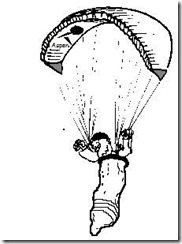Here we go – I can feel the excitement building as we get ready to hit the air again and try to avoid hitting the ground. I was halfway through writing a ‘get ready’ post when one popped up on the CSC forum from Tim Oliver. I couldn’t improve on this so I’m grateful to Tim for permission to reproduce it here. There are countless sources of advice on how to get back to flight currency, but I think Tim’s approach sums it all up clearly and concisely. Also look back to my January notes and the flying currency calculator.
Before you dive straight in, take time to reflect. Staying current is a key part of staying safe. Yet NONE of us are current. Many of us have not flown for almost a year. You are not the pilot you were! Think about taking a planned, staged, and safe return to the air.
Before getting out on the hill, consider using visualisation techniques to refresh your memory and rehearse the process. Work your way through laying out, getting kitted up, securing the harness, switching on instruments, pre-flight checks, lifting the glider, turning, take off and flight. Visualise active flying and dealing with collapses. Visualise grabbing and throwing your reserve. Visualise landing and killing your wing.
Before you set off to fly for real, get your kit out, check the wing, lines, harness, and reserve closure. Charge your instruments and radio and remind yourself of the key functions.
Remind yourself of the air rules. Which side do you pass when ridge soaring?
If you have bought new kit since lockdown began, think twice about using it for the first few flights. Better to start with what is familiar. Fiddling around with the adjustments on a harness or scrolling through shiny new screens is distracting. You need your focus to be on piloting and observing.
Make a plan for your return to flying. Think of the key flying skills and commit to working your way through them methodically before you seek out that rocket thermal.
Get out and ground handle, ground handle, ground handle.
For the first few flights, pick familiar safer sites and friendly conditions. It’s probably best to avoid cheek clenching take-off sites like Walla. Remember to check specific site status on the club website. Not every site may be open. It’s spring so be aware of the potential for rough air. It it’s sunny, consider avoiding in the middle of the day.
• Aim to get some smooth soaring time before tackling thermals again.
• Make a few practice grabs at your reserve handle.
• Practice pitch control and get familiar with the brake positions.
• Practice flat turns then tight turns with weight shift.
• Put in some 360’s away from the hill and then closer to the hill.
• Try some gentle wing-overs.
• Practice using speed bar.
• Then big ears and speed bar.
Watch out for other pilots, everyone is rusty so give all pilots plenty of space. Follow the air rules. Look before you turn and exaggerate your movements to make it obvious to others when and which way you are turning. Keep your head up and look around, don’t faff around with your instruments.
Be safe and enjoy!
Finally, remember the CANP procedure for mid-week flying. There was an update about the Low Fying Booking Cell (LFBC) in Skywings this month, but in case you missed it:
· (LFBC) Operating Hours: 0700 – 2000 Mon – Thurs; 0700 – 1500 Fri
· Email SWK-MAMC-Lowflying@mod.gov.uk
· Phone: 01489 443100 or 0800 515544
· Web: https://canp.logans.me.uk/bookings.php (recommended method of submission)
Tight lines everyone,
Brian
Safety Officer
